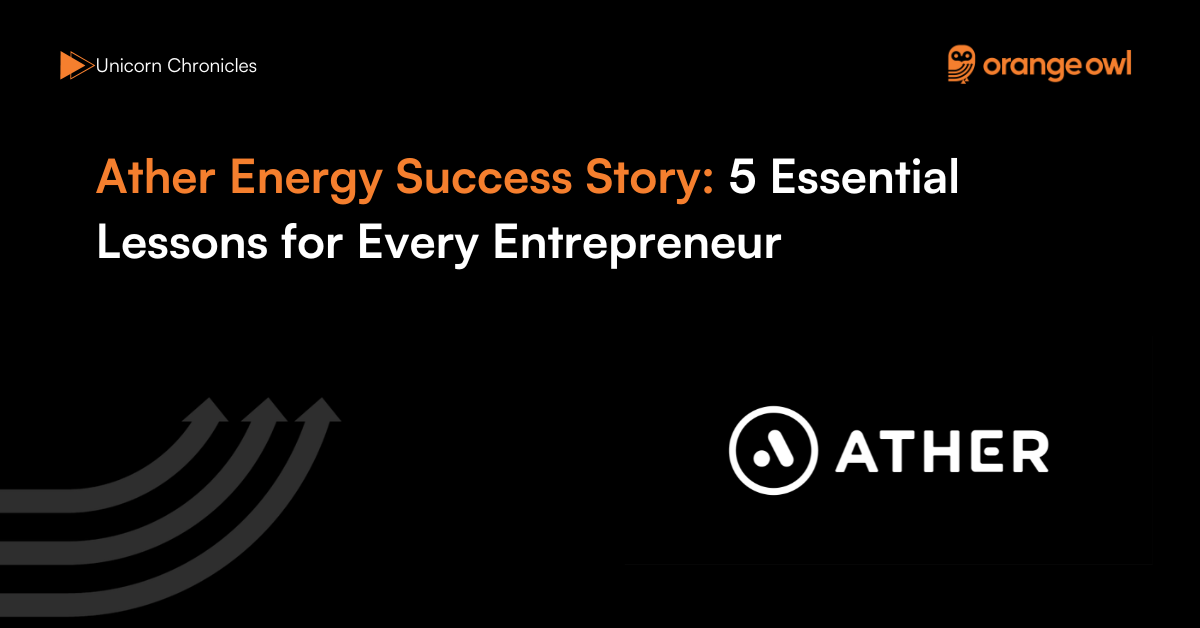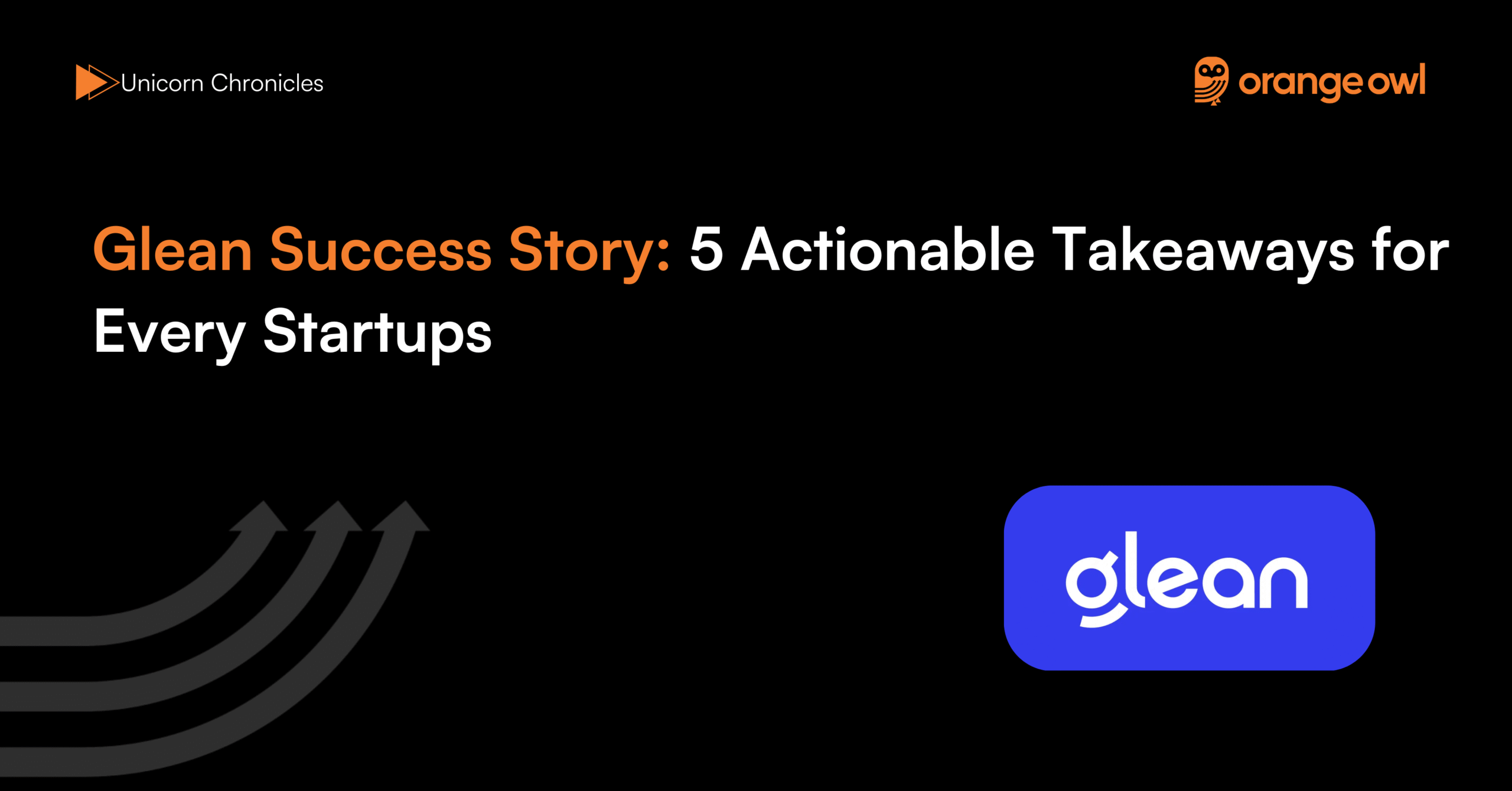Ather Energy Success Story: 5 Essential Lessons for Every Entrepreneur
Vivek Goel
June 5, 2025

Table of Contents
Introduction
In the rapidly evolving landscape of electric mobility, Ather Energy has emerged as a pioneering force in India’s electric scooter market. Founded in 2013 by Tarun Mehta and Swapnil Jain, Ather set out to revolutionize urban transport with smart, high-performance electric vehicles and a robust charging infrastructure.
Over the past decade, the Indian electric two-wheeler market has witnessed exponential growth, reaching a market size of over 2.5 million units sold in 2024, with Ather capturing around 12% market share — a significant feat given the competition from both established and new players. Today, Ather Energy is valued at approximately $1.37 billion (as of mid-2025), making it one of India’s first electric vehicle startups to achieve unicorn status.
Ather’s success is driven by their focus on innovation, customer experience, and building an extensive charging network, which now comprises more than 1,000 fast-charging points across 80+ cities in India. Their user base has grown impressively from just 23,000 scooters on the road in early 2022 to over 1,14,000 by March 2024, signaling robust consumer adoption of electric mobility solutions. This growth has contributed significantly to India’s broader goal of reducing vehicular emissions and promoting sustainable urban transport, where the government aims to have electric vehicles make up 30% of total vehicle sales by 2030.
Their journey highlights the importance of product innovation, customer focus, and ecosystem building in disrupting traditional industries and accelerating the transition toward sustainable mobility.
As Tarun Mehta noted in an interview,
“We wanted to create not just an electric scooter but a complete smart mobility experience for Indian consumers.”
Origin Story
The genesis of Ather Energy traces back to the shared concerns of its founders, Tarun Mehta and Swapnil Jain, about the severe pollution and congested urban transport conditions prevalent in many Indian cities. Both graduates of IIT Madras, they were passionate about technology and sustainability from early on.
During their college years, they began experimenting with electric vehicle prototypes, driven by the ambition to address the glaring gap in India’s urban mobility — a market dominated by petrol-powered two-wheelers with little to no sustainable alternatives.
Inspired by the global electric vehicle revolution and realizing that India’s unique traffic patterns and road conditions required specially designed vehicles, they envisioned creating electric scooters that were not only environmentally friendly but also smart, reliable, and tailored to Indian consumers’ needs.
They formally launched Ather Energy in Bangalore in 2013 with a clear mission: to build high-quality, technology-driven electric scooters that could change the way Indians commute.
However, this vision came with significant technical challenges. The founders had to overcome hurdles related to hardware design, battery efficiency, motor reliability, and overall vehicle durability.
They understood early on that simply replacing petrol engines with electric motors wouldn’t be enough; the scooters had to deliver superior performance and a user experience comparable or better than traditional scooters. This required intense research and development, iterative prototyping, and a relentless pursuit of innovation.
Business Space and Early Challenges
Entering India’s electric vehicle market in 2013 meant stepping into largely uncharted territory. The ecosystem was underdeveloped — public charging infrastructure was almost non-existent, and manufacturing costs for electric vehicles were significantly higher than conventional scooters.
Consumer trust was a major barrier; the average Indian buyer was skeptical about EVs’ range, battery life, maintenance costs, and reliability, given their limited exposure to such technology.
Furthermore, regulatory frameworks supporting electric vehicles were nascent and inconsistent, often lacking clear incentives or subsidies in the early years. Competing with established two-wheeler manufacturers like Hero MotoCorp, Honda, and TVS — brands with decades of experience and deep customer loyalty — made the market even tougher to crack.
Tarun Mehta recalled the difficulty of securing investor confidence in the initial stages:
“Initially, investors and even customers found it hard to believe that an Indian startup could build a world-class electric scooter.”
This skepticism extended beyond investment circles into the consumer market, where traditional petrol scooters dominated due to their affordability and proven performance.
What set Ather apart was its unwavering commitment to quality and technology. Instead of outsourcing critical components, Ather invested heavily in building its own battery packs and electric motors, tailored specifically for Indian conditions. This in-house development approach allowed them to optimize performance, increase reliability, and reduce costs over time.
Beyond the scooter itself, Ather Energy understood the importance of creating an entire ecosystem. They pioneered the concept of fast-charging networks in India, launching “Ather Grids” — strategically located charging stations across cities to alleviate range anxiety. Their scooters featured smart dashboards with real-time data, OTA software updates, and connected apps that allowed customers to monitor vehicle health and receive support seamlessly.
By focusing on these differentiators — superior product design, customer-centric features, and ecosystem building — Ather steadily gained traction, turning early challenges into opportunities for innovation and leadership in the Indian EV space.
Growth Strategies
Ather Energy’s rise in the Indian electric two-wheeler market can be attributed to a series of well-planned and executed growth strategies that set them apart from conventional players. A cornerstone of their success was innovative product design, exemplified by the launch of the Ather 450.
This electric scooter was not just another eco-friendly alternative; it featured a powerful motor, a smart touchscreen dashboard with navigation, onboard diagnostics, and fast-charging capabilities — features that transformed the scooter into a premium tech product rather than just a mode of transport. This positioned Ather firmly in the high-end segment, appealing to urban consumers seeking performance, technology, and sustainability.
Another critical growth lever was Ather Grid, their proprietary fast-charging infrastructure. By proactively building a network of public fast-charging stations across multiple cities, Ather addressed one of the biggest consumer concerns — range anxiety.
This infrastructure strategy wasn’t just a support function; it became a major differentiator in the market and a key part of Ather’s value proposition. As of 2025, Ather has deployed over 1,500 charging points in 100+ cities, making electric commuting increasingly viable and convenient.
In terms of retail and customer acquisition, Ather adopted a direct-to-consumer (D2C) sales model. By selling online and through their exclusive Ather Experience Centers, they ensured complete control over the customer journey — from test rides and product demos to final delivery and after-sales service. This allowed the brand to offer personalized, tech-enabled, and premium interactions that enhanced trust and loyalty.
Strategic funding and partnerships also played a vital role in scaling their operations. Key investments from Hero MotoCorp, which now holds over 30% stake in Ather, along with support from global investors like Tiger Global, enabled Ather to expand its manufacturing capabilities, invest in R&D, and extend its market presence. The opening of a new production facility in Hosur, Tamil Nadu, helped significantly increase output — a move that supported their rapid sales growth.
Lastly, Ather’s customer-first approach stood out in the Indian auto landscape. They actively integrated user feedback into product iterations and rolled out frequent over-the-air (OTA) software updates, much like a tech company would. This approach not only improved vehicle performance and user experience over time but also built a sense of ownership and involvement among early adopters, contributing to stronger brand loyalty.
Marketing Strategies
Unlike legacy two-wheeler manufacturers that leaned heavily on traditional advertising and pricing-led promotions, Ather Energy embraced a fresh and modern approach to marketing. The company positioned its scooters as smart, connected, and aspirational gadgets, aligning with a lifestyle of innovation and sustainability.
This strategic positioning was reflected in every element of their marketing — from the product design language and website UX to the tone of their social media and advertising campaigns.
Ather focused on digital-first and experiential marketing to reach its core audience of urban millennials and tech-savvy consumers. They leveraged platforms like YouTube, Instagram, and Twitter to highlight product features, customer stories, and technology demonstrations.
At the same time, they created interactive Experience Centers — immersive retail spaces where customers could explore the vehicle’s features, engage with the dashboard interface, take test rides, and understand the ecosystem Ather was building. These spaces functioned more like Apple Stores than typical two-wheeler showrooms, helping build a deeper emotional connection with the brand.
Another powerful pillar of their marketing was community building. Ather organized regular customer meetups, EV rallies, and test-ride events, fostering a growing community of early adopters who advocated for electric mobility. They highlighted real stories and user journeys to build trust and relatability, rather than relying solely on celebrity endorsements or paid promotions.
As co-founder Swapnil Jain noted,
“Our marketing is less about selling a vehicle and more about building a community of users who believe in the future of electric mobility.”
This community-driven, purpose-led narrative helped Ather stand out as more than just a vehicle manufacturer — it became a brand associated with smart, sustainable living.
5 Essential Lessons for Every Entrepreneur
1. Solve a Real Problem with Technology
At the heart of Ather Energy’s success is its ability to identify and tackle a real, large-scale problem — urban pollution and the inefficiency of traditional mobility. Instead of simply entering the electric vehicle market to follow a trend, the founders deeply analyzed the gaps in India’s transportation ecosystem.
They realized that Indian cities needed more than just electric scooters — they needed smart, connected, and efficient solutions for everyday commuting. Ather addressed this with in-house innovations like the Ather 450’s touchscreen dashboard, fast charging, and software-enabled performance upgrades. This lesson reinforces that true disruption happens when technology is used to solve core pain points, not just create a slightly better version of what’s already available.
2. Build the Ecosystem, Not Just the Product
Ather understood early on that even the most advanced electric scooter wouldn’t succeed in isolation — customers also needed the infrastructure to support it. To that end, the company built Ather Grid, a proprietary network of fast-charging stations, which became a game changer. This move addressed a major barrier to EV adoption: range anxiety.
By investing in the ecosystem — not just the vehicle — Ather gave consumers the confidence to switch. This teaches entrepreneurs that building a great product is not enough; creating the supporting systems around the product can often be just as critical for long-term adoption and market penetration.

3. Invest in Customer Experience
From the sleek design of the scooters to intuitive user interfaces and frequent software updates, Ather treated every interaction as a touchpoint for customer delight. Their Experience Centers offered immersive, Apple Store-like environments where users could explore every aspect of the vehicle before purchase.
Moreover, they prioritized after-sales support, integrated feedback loops, and remote diagnostics via their app. All these measures created a sense of trust, personalization, and loyalty among early adopters. The takeaway: investing in end-to-end customer experience not only differentiates a brand but also builds strong brand advocates who help fuel organic growth.
4. Be Ready to Iterate
Ather’s initial prototypes were far from perfect. The team faced challenges with battery safety, range, performance, and even basic production issues. However, rather than giving up or rushing to market with a subpar product, they embraced iteration.
Every version of the Ather scooter came with improvements based on internal testing and real-world user feedback. This agile mindset helped them adapt to consumer needs and continually enhance their offerings. Entrepreneurs must remember that setbacks are part of the process, and a willingness to iterate — sometimes even radically — is essential for long-term success.
5. Partner Strategically for Scale
Growth at scale requires more than just a great product; it requires capital, expertise, and operational support. Ather recognized this and aligned with industry veterans like Hero MotoCorp, who brought deep manufacturing knowledge and funding.
These partnerships enabled Ather to expand production, improve supply chains, and reach more cities across India. Strategic investors like Tiger Global added global credibility and financial strength. This illustrates the importance of choosing partners who align with your vision and can help you scale without diluting the company’s core mission or values.
Conclusion
Ather Energy’s journey from a bold startup idea in a college lab to becoming a frontrunner in India’s electric vehicle (EV) revolution is nothing short of inspirational. In an industry dominated by legacy players and fueled by skepticism about EVs, Ather dared to challenge the norm. Their relentless pursuit of innovation — from building smart, high-performance scooters to creating a fast-charging network and prioritizing seamless customer experiences — reflects a deep understanding of what it takes to disrupt a traditional market.
What sets Ather apart is not just their product, but their holistic approach to ecosystem building. Instead of waiting for infrastructure or regulations to catch up, they took matters into their own hands and created Ather Grid, redefined how EVs are sold through direct-to-consumer experience centers, and used data-driven insights to constantly upgrade their offerings. This commitment to long-term thinking over short-term gains became a cornerstone of their success.
Moreover, Ather’s story highlights the importance of resilience. In the face of technical setbacks, regulatory ambiguity, and market hesitance, the founders remained committed to their vision of sustainable and smart urban mobility. Their ability to attract major investors and industry partners further validated their strategy and scaled their impact.
As India races toward an electric future, Ather Energy stands not just as a successful company, but as a symbol of what vision-driven entrepreneurship can achieve in transforming industries and making a tangible difference.


